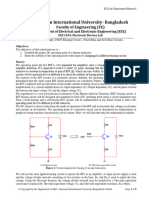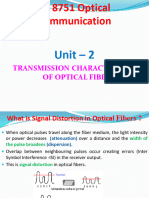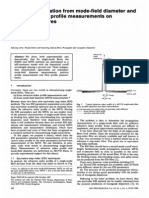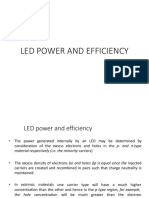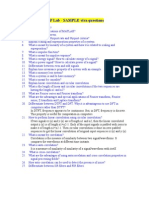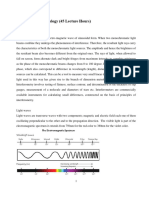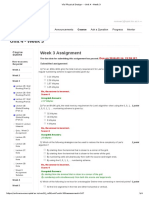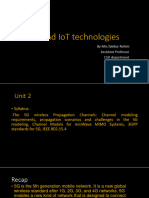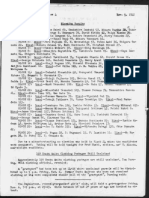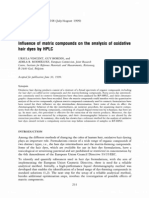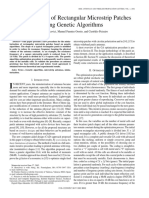Lecture 5:
Waveguiding in optical fibers
Meridional / skew rays and their vectorial characteristics
Concept of linearly polarized modes
Cutoff condition / wavelength
Selected key concepts on singlemode fibers
Advanced materials
Field analysis of the weakly guiding fiber*
Solving the wave equation*
Eigenvalue equation for linearly polarized modes*
Reading: Senior 2.4.1, 2.4.3, 2.5.1, 2.5.2, 2.5.3
Keiser 2.3 2.8
Part of the lecture materials were adopted from powerpoint slides of Gerd Keisers book 2010,
Copyright The McGraw-Hill Companies, Inc.
�Meridional and skew rays
A meridional ray is one that has no component it
passes through the z axis, and is thus in direct analogy
to a slab guide ray.
Ray propagation in a fiber is complicated by the
possibility of a path component in the direction, from
which arises a skew ray.
Such a ray exhibits a spiral-like path down the core,
never crossing the z axis.
�Skew ray decomposition in the core of a step-index fiber
(n1k0)2 = r2 + 2 + 2 = t2 + 2
3
�Vectorial characteristics of modes in optical fibers
TE (i.e. Ez = 0) and TM (Hz = 0) modes are also obtained within the
circular optical fiber. These modes correspond to meridional rays
(pass through the fiber axis).
As the circular optical fiber is bounded in two dimensions in the
transverse plane,
=> two integers, l and m, are necessary in order to specify the modes
i.e. We refer to these modes as TElm and TMlm modes.
core
cladding
fiber axis
x
core
cladding
� Hybrid modes are modes in which both Ez and Hz are nonzero.
These modes result from skew ray propagation (helical path without
passing through the fiber axis). The modes are denoted as HElm
and EHlm depending on whether the components of H or E make
the larger contribution to the transverse field.
core
cladding
The full set of circular optical fiber modes therefore comprises:
TE, TM (meridional rays), HE and EH (skew rays) modes.
�Weak-guidance approximation
The analysis may be simplified when considering telecommunicationsgrade optical fibers. These fibers have the relative index difference
<< 1 ( = (ncore nclad)/ncore typically less than 1 %).
=> the propagation is preferentially along the fiber axis ( 90o).
i.e. the field is therefore predominantly transverse.
=> modes are approximated by two linearly polarized components.
(both Ez and Hz are nearly zero)
<< 1
z
Two near linearly polarized modes
� These linearly polarized (LP) modes, designated as LPlm, are
good approximations formed by exact modes TE, TM, HE and EH.
The mode subscripts l and m describe the electric field intensity
profile. There are 2l field maxima around the the fiber core
circumference and m field maxima along the fiber core radial direction.
core
fundamental
mode (LP01)
LP21
Electric field
intensity
LP11
LP02
7
�Intensity plots for the first six LP modes
LP01
LP02
LP11
LP31
LP21
LP12
�Plot of the propagation constant b as a function of
V for various LP modes
2.405
V = (2a/) (n12 n22)1/2 = (u2 + w2)1/2
b = (2 k22)/(k12 k22)
(see p.37)
�VNumberDefinition
Animportantparameterconnectedwiththecutoff
conditionistheVnumberdefinedby
10
�The total number of guided modes M for a step-index fiber is
approximately related to the V number (for V > 20) as follows,
M V2 / 2
e.g. A multimode step-index fiber with a core diameter of 80 m and
a relative index difference of 1.5 % is operating at a wavelength of
0.85 m. If the core refractive index is 1.48, estimate (a) the normalized
frequency for the fiber; (b) the number of guided modes.
(a) V = (2/) a n1 (2)1/2 = 75.8
(b) M V2 / 2 = 2873 (i.e. nearly 3000 guided modes!)
11
�Cutoff wavelength
The cutoff wavelength for any mode is defined as the
maximum wavelength at which that mode propagates. It is the
value of that corresponds to Vc for the mode concerns. For
each LP mode, the two parameters are related
c(lm) = (2a/(Vc(lm)) (n12 n22)1/2
The range of wavelengths over which mode lm will propagate
is thus 0 < < c(lm).
For a fiber to operate single mode, the operating wavelength
must be longer than the cutoff wavelength for the LP11 mode.
This is an important specification for a single-mode fiber, and
is usually given the designation c. We find c by setting Vc =
2.405. The range of wavelengths for singlemode operation is 12
> c.
�Singlemode condition
For single-mode operation, only the fundamental LP01 mode exists.
The cutoff normalized frequency (Vc) for the next higher order (LP11)
mode in step-index fibers occurs at Vc = 2.405.
=> single-mode propagation of the LP01 mode in step-index fibers:
V < 2.405
e.g. Determine the cutoff wavelength for a step-index fiber to exhibit
single-mode operation when the core refractive index is 1.46 and the core radius is
4.5 m, with the relative index difference of 0.25 %.
c = (2an1/2.405) (2)1/2 = 1214 nm.
Hence, the fiber is single-mode for > 1214 nm.
13
�SingleModeFibers
Singlemodefiberfeatures:
Thedimensionofthecorediameterisafew
wavelengths(usually812)
Theindexdifferencebetweenthecoreand
thecladdingissmall(0.2to1.0%)
Thecorediameterisjustbelowthecutoffof
thefirsthigherordermode:V<2.405
14
�Gaussian approximation for the LP01 mode field
The LP01 mode intensity varies with radius as J02(ur/a)
inside the core and as K02(wr/a) in the cladding. The
resultant intensity profile turns out to closely fits a
Gaussian function having a width w0, known as the
mode-field radius.
This is defined as the radial distance from the core
center to the 1/e2 point of the Gaussian intensity profile.
A similar Gaussian approximation can be applied to the
fundamental symmetric slab waveguide mode.
E(r) = E(0) exp (-r2 / w02)
=>
I(r) = I(0) exp(-2r2/w02)
15
�Mode-field diameter (MFD) = 2w0 (rather than the core diameter)
characterizes the functional properties of single-mode fibers.
(w0 is also called the spot size.)
ncore
Corning SMF-28 single-mode
fiber has MFD:
nclad
core dia.
9.2 m at 1310 nm
10.4 m at 1550 nm
core diameter: 8.2 m
MFD > core diameter
MFD
16
�ModalFieldPatterns
Electric field distributions of lower-order guided modes in a planar
dielectric slab waveguide (or cross-sectional view of an optical
fiber along its axis)
Evanescent tails extend into
the cladding
Zeroth
order mode
First
order mode
Second
order mode
Zeroth-order mode = Fundamental mode
A single-mode fiber carries only the fundamental mode
17
�Mode-field diameter vs. wavelength
11 m
c ~ 1270 nm
= 1550 nm
= 1320 nm
1550 nm
core
Mode-field intensity distribution can be measured directly by
near-field imaging the fiber output.
Why characterize the MFD for single-mode fibers?
18
�ModeFieldDiameter
Themodefielddiameter (MFD)canbedeterminedfromthe
modefielddistributionofthefundamentalfibermodeand
isafunctionoftheopticalsourcewavelength
TheMFDisusedtopredictfiberspliceloss,bendingloss,
cutoffwavelength,andwaveguidedispersion
TofindMFD:(a)measurethefarfieldintensitydistribution
E2(r)(b)calculatetheMFDusingthePetermannIIequation
19
�Mismatches in mode-field diameter can increase fiber splice loss.
e.g. Splicing loss due to MFD mismatch between two different
SMFs
~ dB loss per splice
8 m
10 m
SMF1
splicing
SMF2
(A related question: why do manufacturers standardize the
cladding diameter?)
20
�Remarks on single-mode fibers:
no cutoff for the fundamental mode
there are in fact two modes with orthogonal polarization
21
�Fiber birefringence
In ideal fibers with perfect rotational symmetry, the two
modes are degenerate with equal propagation constants
(x = y), and any polarization state injected into the fiber
will propagate unchanged.
In actual fibers there are imperfections, such as
asymmetrical lateral stresses, noncircular cores, and
variations in refractive-index profiles. These
imperfections break the circular symmetry of the ideal
fiber and lift the degeneracy of the two modes.
The modes propagate with different phase velocities,
and the difference between their effective refractive
indices is called the fiber birefringence,
B = |ny nx|
22
�Real optical fiber geometry is by no means perfect.
Corning SMF-28 single-mode fiber glass geometry
1. cladding diameter: 125.0 0.7 m
2. core-cladding concentricity: < 0.5 m
3. cladding non-circularity: < 1%
[1- (min cladding dia./max clad dia.)]
23
� State-of-polarization in a constant birefringent fiber over one
beat length. Input beam is linearly polarized between
the slow and fast axes.
2
3/2
/2
fast
axis
slow
axis
th
g
n
le
t
a
Be
Lbeat = / B ~ 1 m
(B ~ 10-6)
*In optical pulses, the polarization state will also be different for
24
different spectral components of the pulse.
�GradedIndexFiberStructure
Thecoreindexdecreaseswithincreasingdistancer fromthe
centerofthefiberbutisgenerallyconstantinthecladding.
Themostcommonlyusedconstructionfortherefractiveindex
variationinthecoreisthepowerlawrelationship:
A typical value
of is 2.0
The local numerical aperture is defined as
25
�FiberMaterials(1)
Sincethefibercladdingmusthavealowerindexthanthecore,
examplesofglassfibercompositionsare
1.GeO2SiO2core;SiO2cladding
2.P2O5SiO2core;SiO2cladding
3.SiO2core;B2O3SiO2cladding
4.GeO2B2O3SiO2core;B2O3SiO2cladding
26
�FiberMaterials(2)
Thegrowingdemandfordeliveringhighspeed
servicesdirectlytotheworkstationhasledtohigh
bandwidthgradedindexpolymer(plastic)optical
fibers (POF)foruseinacustomerpremises
27
�PhotonicCrystalFibers(PCF)
ThecoreregionsofaPCFcontainairholes,whichrunalong
theentirelengthofthefiber
ThePCFmicrostructureoffersextradimensionsincontrolling
effectssuchasdispersion,nonlinearity,andbirefringence
ThetwobasicPCFcategoriesareindexguidingfibers(left)
andphotonicbandgapfibers(right)
28
�Advanced materials
Field analysis of the weakly guiding
fiber*
Solving the wave equation*
Eigenvalue equation for Linearly
Polarized modes*
29
�Field analysis of the weakly guiding fiber
Here we begin the LP mode analysis by assuming field
solutions that are linearly polarized in the fiber
transverse plane.
These consist of an electric field that can be designated
as having x-polarization and a magnetic field that is
polarized along y
the weak-guidance character of the fiber results in nearly
plane wave behavior for the fields, in which E and H are
orthogonal and exist primarily in the transverse plane
(with very small z components).
E = ax Ex(r, , z) = ax Ex0(r, ) exp (iz)
H = ay Hy(r, , z) = ay Hy0(r, ) exp (iz)
30
� Because rectangular components are assumed for the
fields, the wave equation
t2E0 + (k2 2) E0 = 0
is fully separable into the x, y and z components
t2Ex1 + (n12k02 2) Ex1 = 0
ra
t2Ex2 + (n22k02 2) Ex2 = 0
ra
where (n12k02 2) = t12 and (n22k02 2) = t22
31
� Assuming transverse variation in both r and , we find for
the wave equation, in either region
2Ex/r2 + (1/r)Ex/r + (1/r2)2Ex/2 + t2Ex = 0
We assume that the solution for Ex is a discrete series of
modes, each of which has separated dependences on r,
and z in product form:
Ex = Ri(r)i() exp(iiz)
i
Each term (mode) in the expansion must itself be a
solution of the wave equation. A single mode, Ex = R
exp(iz) can be substituted into the wave equation to
obtain
(r2/R) d2R/dr2 + (r/R) dR/dr + r2t2 = -(1/) d2/d2
32
� The left-hand side depends only on r, whereas the righthand side depends only on .
Because r and vary independently, it follows that each
side of the equation must be equal to a constant.
Defining this constant as l2, we can separate the
equation into two equations
d2/d2 + l2 = 0
d2R/dr2 + (1/r) dR/dr + (t2 l2/r2)R = 0
We identify the term l/r as for LP modes.
The bracketed term therefore becomes t2 - l2/r2 = r2
33
�Solving the wave equation
We can now readily obtain solutions to the equation:
() = cos(l + ) or sin (l + )
where is a constant phase shift.
l must be an integer because the field must be selfconsistent on each rotation of through 2.
The quantity l is known as the angular or azimuthal
mode number for LP modes.
34
�Solving the R wave equation
The R-equation is a form of Bessels equation. Its
solution is in terms of Bessel functions and assumes
the form
R(r) = A Jl(tr)
= C Kl(|t|r)
t real
t imaginary
where Jl are ordinary Bessel functions of the first kind of
order l, which apply to cases of real t. If t is imaginary,
then the solution consists of modified Bessel functions
Kl.
35
�Bessel functions
2.405
Ordinary Bessel functions
of the first kind
Modified Bessel functions of
the second kind
The ordinary Bessel function Jl is oscillatory, exhibiting no
singularities (appropriate for the field within the core).
The modified Bessel function Kl resembles an exponential decay
(appropriate for the field in the cladding).
36
� Define normalized transverse phase / attenuation constants,
u = t1a = a(n12k02 2)1/2
w = |t2|a = a(2 n22k02)1/2
Using the cos(l) dependence (with = 0), we obtain the
complete solution for Ex:
Ex = A Jl(ur/a) cos (l) exp(iz)
Ex = C Kl(wr/a) cos (l) exp(iz)
ra
ra
Similarly, we can solve the wave equation for Hy
Hy = B Jl(ur/a) cos (l) exp(iz) r a
Hy = D Kl(wr/a) cos (l) exp(iz) r a
where A Z B and C Z D in the quasi-plane-wave
approximation, and Z Z0/n1 Z0/n2
37
�Electric field for LPlm modes
Applying the field boundary conditions at the core-cladding
interface:
E1|r=a = E2|r=a
n12Er1|r=a = n22Er2|r=a
H1|r=a = H2|r=a
1Hr1|r=a = 2Hr2|r=a
where 1 = 2 = 0, Hr1|r=a = Hr2|r=a.
In the weak-guidance approximation, n1 n2, so Er1|r=a Er2|r=a
Ex1|r=a Ex2|r=a
Hy1|r=a Hy2|r=a
Suppose A = E0,
Ex = E0 Jl(ur/a) cos (l) exp (iz)
(r a)
Ex = E0 [Jl(u)/Kl(w)] Kl(wr/a) cos (l) exp (iz) (r a)
38
�Electric fields of the fundamental mode
The fundamental mode LP01 has l = 0 (assumed xpolarized)
Ex = E0 J0(ur/a) exp (iz)
(r a)
Ex = E0 [J0(u)/K0(w)] K0(wr/a) exp (iz) (r a)
These fields are cylindrically symmetrical, i.e. there is no
variation of the field in the angular direction.
They approximate a Gaussian distribution. (see the J0(x)
distribution)
39
�Intensity patterns
The LP modes are observed as intensity patterns.
Analytically we evaluate the time-average Poynting
vector
|<S>| = (1/2Z) |Ex|2
Defining the peak intensity I0 = (1/2Z) |E0|2, we find the
intensity functions in the core and cladding for any LP
mode
Ilm = I0 Jl2(ur/a) cos2(l)
ra
Ilm = I0 (Jl(u)/Kl(w))2 Kl2(wr/a) cos2(l)
ra
40
�Eigenvalue equation for LP modes
We use the requirement for continuity of the z components of
the fields at r = a
Hz = (i/) ( x E)z
( x E1)z|r=a = ( x E2)z|r=a
Convert E into cylindrical components
E1 = E0 Jl(ur/a) cos(l) (arcos asin ) exp (iz)
E2 = E0 [Jl(u)/Kl(w)] Kl(wr/a) cos(l) (arcos asin ) exp(iz)
41
� Taking the curl of E1 and E2 in cylindrical coordinates:
( x E1)z = (E0/r) {[lJl(ur/a) (ur/a)Jl-1(ur/a)] cos (l) sin
+ lJl(ur/a) sin (l) cos }
( x E2)z = (E0/r)(Jl(u)/Kl(u)){[lKl(wr/a)(wr/a)Kl-1(wr/a)] cos l sin
+ lKl(wr/a) sin (l) cos }
where we have used the derivative forms of Bessel functions.
Using ( x E1)z|r=a = ( x E2)z|r=a
Jl-1(u)/Jl(u) = -(w/u) Kl-1(w)/Kl(w)
This is the eigenvalue equation for LP modes in the step-index
fiber.
42
�Cutoff condition
Cutoff for a given mode can be determined directly from the
eigenvalue equation by setting w = 0,
u = V = Vc
where Vc is the cutoff (or minimum) value of V for the mode
of interest.
The cutoff condition according to the eigenvalue equation is
VcJl-1(Vc)/Jl(Vc) = 0
When Vc 0, Jl-1(Vc) = 0
e.g. Vc = 2.405 as the cutoff value of V for the LP11 mode.43




